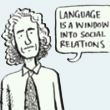Friday, 15 November 2013
Language as a Window into Human Nature

In previous posts in this blog, we have drawn your attention to various lectures in the RSA Animate series, in which experts is a variety of fields give online talks while cartoon illustrations are drawn in sped-up fashion to accompany their voice-over. This week we’d like to tell you about another RSA Animate lecture. This one is about language, and it is given by Harvard cognitive psychologist Steven Pinker.
This talk draws on ideas from Pinker’s 2007 book The Stuff of Thought: Language as a Window into Human Nature, whose explanations about the origins of swearing and curse words have been summarized in another post in this blog. In this RSA Animate lecture, Pinker draws our attention to the fact that language always does two things at once: it conveys a message, and it negotiates a social relationship between the person who is speaking and the person or persons who are listening. Consequently, language always functions on these two levels simultaneously.
For example, if you say something like “If you could pass the salt, that would be awesome”, you are making both a request and a display of politeness. You really want the salt, but you don’t want to offend the other person by seeming to demand it. So instead, you use this formulation, which seems more like the expression of a vague desire. But your intended meaning is unmistakable, and the other person instantly passes you the salt with a smile.
The same kind of veiled communication is going on when the speaker at a fundraising dinner says something like “We’re counting on you to show leadership in our campaign” (i.e., give us as much money as you can), or when a romantic date ends with one person asking the other to come upstairs for a drink (i.e., to have sex). When you think about it, a good part of our conversation operates in this way, taking the context into account, lubricating our social relationships, and preserving the fiction that our own desires coincide with other people’s, which is far from always the case.
![]() RSA Animate – Language as a Window into Human Nature
RSA Animate – Language as a Window into Human Nature
![]() The Stuff of Thought
The Stuff of Thought
From Thought to Language | Comments Closed








